- Home
- Walter Isaacson
The Innovators Page 2
The Innovators Read online
Page 2
The collaboration that created the digital age was not just among peers but also between generations. Ideas were handed off from one cohort of innovators to the next. Another theme that emerged from my research was that users repeatedly commandeered digital innovations to create communications and social networking tools. I also became interested in how the quest for artificial intelligence—machines that think on their own—has consistently proved less fruitful than creating ways to forge a partnership or symbiosis between people and machines. In other words, the collaborative creativity that marked the digital age included collaboration between humans and machines.
Finally, I was struck by how the truest creativity of the digital age came from those who were able to connect the arts and sciences. They believed that beauty mattered. “I always thought of myself as a humanities person as a kid, but I liked electronics,” Jobs told me when I embarked on his biography. “Then I read something that one of my heroes, Edwin Land of Polaroid, said about the importance of people who could stand at the intersection of humanities and sciences, and I decided that’s what I wanted to do.” The people who were comfortable at this humanities-technology intersection helped to create the human-machine symbiosis that is at the core of this story.
Like many aspects of the digital age, this idea that innovation resides where art and science connect is not new. Leonardo da Vinci was the exemplar of the creativity that flourishes when the humanities and sciences interact. When Einstein was stymied while working out General Relativity, he would pull out his violin and play Mozart until he could reconnect to what he called the harmony of the spheres.
When it comes to computers, there is one other historical figure, not as well known, who embodied the combination of the arts and sciences. Like her famous father, she understood the romance of poetry. Unlike him, she also saw the romance of math and machinery. And that is where our story begins.
Ada, Countess of Lovelace (1815–52), painted by Margaret Sarah Carpenter in 1836.
Lord Byron (1788–1824), Ada’s father, in Albanian dress, painted by Thomas Phillips in 1835.
Charles Babbage (1791–1871), photograph taken circa 1837.
CHAPTER ONE
* * *
ADA, COUNTESS OF LOVELACE
POETICAL SCIENCE
In May 1833, when she was seventeen, Ada Byron was among the young women presented at the British royal court. Family members had worried about how she would acquit herself, given her high-strung and independent nature, but she ended up behaving, her mother reported, “tolerably well.” Among those Ada met that evening were the Duke of Wellington, whose straightforward manner she admired, and the seventy-nine-year-old French ambassador Talleyrand, who struck her as “an old monkey.”1
The only legitimate child of the poet Lord Byron, Ada had inherited her father’s romantic spirit, a trait that her mother tried to temper by having her tutored in mathematics. The combination produced in Ada a love for what she took to calling “poetical science,” which linked her rebellious imagination to her enchantment with numbers. For many, including her father, the rarefied sensibilities of the Romantic era clashed with the techno-excitement of the Industrial Revolution. But Ada was comfortable at the intersection of both eras.
So it was not surprising that her debut at court, despite the glamour of the occasion, made less impression on her than her attendance a few weeks later at another majestic event of the London season, at which she met Charles Babbage, a forty-one-year-old widowed science and math eminence who had established himself as a luminary on London’s social circuit. “Ada was more pleased with a party she was at on Wednesday than with any of the assemblages in the grand monde,” her mother reported to a friend. “She met there a few scientific people—amongst them Babbage, with whom she was delighted.”2
Babbage’s galvanizing weekly salons, which included up to three hundred guests, brought together lords in swallow-tail coats and ladies in brocade gowns with writers, industrialists, poets, actors, statesmen, explorers, botanists, and other “scientists,” a word that Babbage’s friends had recently coined.3 By bringing scientific scholars into this exalted realm, said one noted geologist, Babbage “successfully asserted the rank in society due to science.”4
The evenings featured dancing, readings, games, and lectures accompanied by an assortment of seafood, meat, fowl, exotic drinks, and iced desserts. The ladies staged tableaux vivants, in which they dressed in costume to re-create famous paintings. Astronomers set up telescopes, researchers displayed their electrical and magnetic contrivances, and Babbage allowed guests to play with his mechanical dolls. The centerpiece of the evenings—and one of Babbage’s many motives for hosting them—was his demonstration of a model portion of his Difference Engine, a mammoth mechanical calculating contraption that he was building in a fireproof structure adjacent to his home. Babbage would display the model with great drama, cranking its arm as it calculated a sequence of numbers and, just as the audience began to get bored, showed how the pattern could suddenly change based on instructions that had been coded into the machine.5 Those who were especially intrigued would be invited through the yard to the former stables, where the complete machine was being constructed.
Babbage’s Difference Engine, which could solve polynomial equations, impressed people in different ways. The Duke of Wellington commented that it could be useful in analyzing the variables a general might face before going into battle.6 Ada’s mother, Lady Byron, marveled that it was a “thinking machine.” As for Ada, who would later famously note that machines could never truly think, a friend who went with them to the demonstration reported, “Miss Byron, young as she was, understood its working, and saw the great beauty of the invention.”7
Ada’s love of both poetry and math primed her to see beauty in a computing machine. She was an exemplar of the era of Romantic science, which was characterized by a lyrical enthusiasm for invention and discovery. It was a period that brought “imaginative intensity and excitement to scientific work,” Richard Holmes wrote in The Age of Wonder. “It was driven by a common ideal of intense, even reckless, personal commitment to discovery.”8
In short, it was a time not unlike our own. The advances of the Industrial Revolution, including the steam engine, mechanical loom, and telegraph, transformed the nineteenth century in much the same way that the advances of the Digital Revolution—the computer, microchip, and Internet—have transformed our own. At the heart of both eras were innovators who combined imagination and passion with wondrous technology, a mix that produced Ada’s poetical science and what the twentieth-century poet Richard Brautigan would call “machines of loving grace.”
LORD BYRON
Ada inherited her poetic and insubordinate temperament from her father, but he was not the source of her love for machinery. He was, in fact, a Luddite. In his maiden speech in the House of Lords, given in February 1812 when he was twenty-four, Byron defended the followers of Ned Ludd, who were rampaging against mechanical weaving machines. With sarcastic scorn Byron mocked the mill owners of Nottingham, who were pushing a bill that would make destroying automated looms a crime punishable by death. “These machines were to them an advantage, inasmuch as they superseded the necessity of employing a number of workmen, who were left in consequence to starve,” Byron declared. “The rejected workmen, in the blindness of their ignorance, instead of rejoicing at these improvements in arts so beneficial to mankind, conceived themselves to be sacrificed to improvements in mechanism.”
Two weeks later, Byron published the first two cantos of his epic poem Childe Harold’s Pilgrimage, a romanticized account of his wanderings through Portugal, Malta, and Greece, and, as he later remarked, “awoke one morning and found myself famous.” Beautiful, seductive, troubled, brooding, and sexually adventurous, he was living the life of a Byronic hero while creating the archetype in his poetry. He became the toast of literary London and was feted at three parties each day, most memorably a lavish morning dance hosted by Lady Ca
roline Lamb.
Lady Caroline, though married to a politically powerful aristocrat who was later prime minister, fell madly in love with Byron. He thought she was “too thin,” yet she had an unconventional sexual ambiguity (she liked to dress as a page boy) that he found enticing. They had a turbulent affair, and after it ended she stalked him obsessively. She famously declared him to be “mad, bad, and dangerous to know,” which he was. So was she.
At Lady Caroline’s party, Lord Byron had also noticed a reserved young woman who was, he recalled, “more simply dressed.” Annabella Milbanke, nineteen, was from a wealthy and multi-titled family. The night before the party, she had read Childe Harold and had mixed feelings. “He is rather too much of a mannerist,” she wrote. “He excels most in the delineation of deep feeling.” Upon seeing him across the room at the party, her feelings were conflicted, dangerously so. “I did not seek an introduction to him, for all the women were absurdly courting him, and trying to deserve the lash of his Satire,” she wrote her mother. “I am not desirous of a place in his lays. I made no offering at the shrine of Childe Harold, though I shall not refuse the acquaintance if it comes my way.”9
That acquaintance, as it turned out, did come her way. After he was introduced to her formally, Byron decided that she might make a suitable wife. It was, for him, a rare display of reason over romanticism. Rather than arousing his passions, she seemed to be the sort of woman who might tame those passions and protect him from his excesses—as well as help pay off his burdensome debts. He proposed to her halfheartedly by letter. She sensibly declined. He wandered off to far less appropriate liaisons, including one with his half sister, Augusta Leigh. But after a year, Annabella rekindled the courtship. Byron, falling more deeply in debt while grasping for a way to curb his enthusiasms, saw the rationale if not the romance in the possible relationship. “Nothing but marriage and a speedy one can save me,” he admitted to Annabella’s aunt. “If your niece is obtainable, I should prefer her; if not, the very first woman who does not look as if she would spit in my face.”10 There were times when Lord Byron was not a romantic. He and Annabella were married in January 1815.
Byron initiated the marriage in his Byronic fashion. “Had Lady Byron on the sofa before dinner,” he wrote about his wedding day.11 Their relationship was still active when they visited his half sister two months later, because around then Annabella got pregnant. However, during the visit she began to suspect that her husband’s friendship with Augusta went beyond the fraternal, especially after he lay on a sofa and asked them both to take turns kissing him.12 The marriage started to unravel.
Annabella had been tutored in mathematics, which amused Lord Byron, and during their courtship he had joked about his own disdain for the exactitude of numbers. “I know that two and two make four—and should be glad to prove it too if I could,” he wrote, “though I must say if by any sort of process I could convert two and two into five it would give me much greater pleasure.” Early on, he affectionately dubbed her the “Princess of Parallelograms.” But when the marriage began to sour, he refined that mathematical image: “We are two parallel lines prolonged to infinity side by side but never to meet.” Later, in the first canto of his epic poem Don Juan, he would mock her: “Her favourite science was the mathematical. . . . She was a walking calculation.”
The marriage was not saved by the birth of their daughter on December 10, 1815. She was named Augusta Ada Byron, her first name that of Byron’s too-beloved half sister. When Lady Byron became convinced of her husband’s perfidy, she thereafter called her daughter by her middle name. Five weeks later she packed her belongings into a carriage and fled to her parents’ country home with the infant Ada.
Ada never saw her father again. Lord Byron left the country that April after Lady Byron, in letters so calculating that she earned his sobriquet of “Mathematical Medea,” threatened to expose his alleged incestuous and homosexual affairs as a way to secure a separation agreement that gave her custody of their child.13
The opening of canto 3 of Childe Harold, written a few weeks later, invokes Ada as his muse:
Is thy face like thy mother’s, my fair child!
Ada! sole daughter of my house and of my heart?
When last I saw thy young blue eyes they smiled,
And then we parted.
Byron wrote these lines in a villa by Lake Geneva, where he was staying with the poet Percy Bysshe Shelley and Shelley’s future wife, Mary. It rained relentlessly. Trapped inside for days, Byron suggested they write horror stories. He produced a fragment of a tale about a vampire, one of the first literary efforts on that subject, but Mary’s story was the one that became a classic: Frankenstein, or The Modern Prometheus. Playing on the ancient Greek myth of the hero who crafted a living man out of clay and snatched fire from the gods for human use, Frankenstein was the story of a scientist who galvanized a man-made assemblage into a thinking human. It was a cautionary tale about technology and science. It also raised the question that would become associated with Ada: Can man-made machines ever truly think?
The third canto of Childe Harold ends with Byron’s prediction that Annabella would try to keep Ada from knowing about her father, and so it happened. There was a portrait of Lord Byron at their house, but Lady Byron kept it securely veiled, and Ada never saw it until she was twenty.14
Lord Byron, by contrast, kept a picture of Ada on his desk wherever he wandered, and his letters often requested news or portraits of her. When she was seven, he wrote to Augusta, “I wish you would obtain from Lady B some accounts of Ada’s disposition. . . . Is the girl imaginative? . . . Is she passionate? I hope that the Gods have made her anything save poetical—it is enough to have one such fool in the family.” Lady Byron reported that Ada had an imagination that was “chiefly exercised in connection with her mechanical ingenuity.”15
Around that time, Byron, who had been wandering through Italy, writing and having an assortment of affairs, grew bored and decided to enlist in the Greek struggle for independence from the Ottoman Empire. He sailed for Missolonghi, where he took command of part of the rebel army and prepared to attack a Turkish fortress. But before he could engage in battle, he caught a violent cold that was made worse by his doctor’s decision to treat him by bloodletting. On April 19, 1824, he died. According to his valet, among his final words were “Oh, my poor dear child!—my dear Ada! My God, could I have seen her! Give her my blessing.”16
ADA
Lady Byron wanted to make sure that Ada did not turn out like her father, and part of her strategy was to have the girl rigorously study math, as if it were an antidote to poetic imagination. When Ada, at age five, showed a preference for geography, Lady Byron ordered that the subject be replaced by additional arithmetic lessons, and her governess soon proudly reported, “She adds up sums of five or six rows of figures with accuracy.” Despite these efforts, Ada developed some of her father’s propensities. She had an affair as a young teenager with one of her tutors, and when they were caught and the tutor banished, she tried to run away from home to be with him. In addition, she had mood swings that took her from feelings of grandiosity to despair, and she suffered various maladies both physical and psychological.
Ada accepted her mother’s conviction that an immersion in math could help tame her Byronic tendencies. After her dangerous liaison with her tutor, and inspired by Babbage’s Difference Engine, she decided on her own, at eighteen, to begin a new series of lessons. “I must cease to think of living for pleasure or self-gratification,” she wrote her new tutor. “I find that nothing but very close and intense application to subjects of a scientific nature now seems to keep my imagination from running wild. . . . It appears to me that the first thing is to go through a course of Mathematics.” He agreed with the prescription: “You are right in supposing that your chief resource and safeguard at the present is in a course of severe intellectual study. For this purpose there is no subject to be compared to Mathematics.”17 He prescribed Euclidean geomet
ry, followed by a dose of trigonometry and algebra. That should cure anyone, they both thought, from having too many artistic or romantic passions.
Her interest in technology was stoked when her mother took her on a trip through the British industrial midlands to see the new factories and machinery. Ada was particularly impressed with an automated weaving loom that used punch cards to direct the creation of the desired fabric patterns, and she drew a sketch of how it worked. Her father’s famous speech in the House of Lords had defended the Luddites who had smashed such looms because of their fear of what technology might inflict on humanity. But Ada waxed poetical about them and saw the connection with what would someday be called computers. “This Machinery reminds me of Babbage and his gem of all mechanism,” she wrote.18
Ada’s interest in applied science was further stimulated when she met one of Britain’s few noted female mathematicians and scientists, Mary Somerville. Somerville had just finished writing one of her great works, On the Connexion of the Physical Sciences, in which she tied together developments in astronomy, optics, electricity, chemistry, physics, botany, and geology.I Emblematic of the time, it provided a unified sense of the extraordinary endeavors of discovery that were under way. She proclaimed in her opening sentence, “The progress of modern science, especially within the last five years, has been remarkable for a tendency to simplify the laws of nature and to unite detached branches by general principles.”
Somerville became a friend, teacher, inspiration, and mentor to Ada. She met with Ada regularly, sent her math books, devised problems for her to solve, and patiently explained the correct answers. She was also a good friend of Babbage’s, and during the fall of 1834 she and Ada would often visit his Saturday-evening salons. Somerville’s son, Woronzow Greig, aided Ada’s efforts to settle down by suggesting to one of his former classmates at Cambridge that she would make a suitable—or at least interesting—wife.

 Benjamin Franklin: An American Life
Benjamin Franklin: An American Life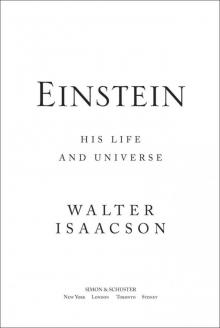 Einstein: His Life and Universe
Einstein: His Life and Universe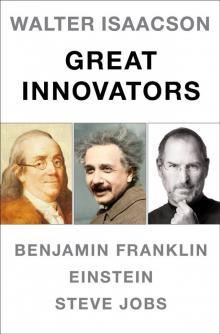 Walter Isaacson Great Innovators e-book boxed set
Walter Isaacson Great Innovators e-book boxed set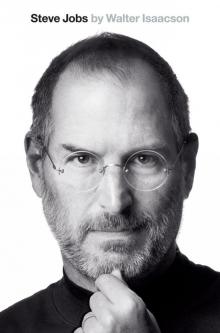 Steve Jobs
Steve Jobs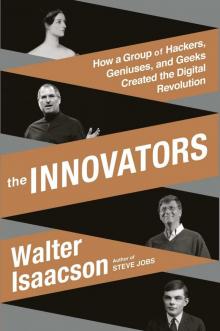 The Innovators
The Innovators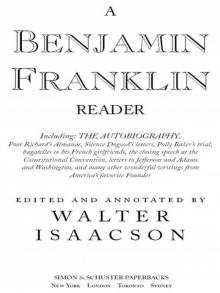 A Benjamin Franklin Reader
A Benjamin Franklin Reader